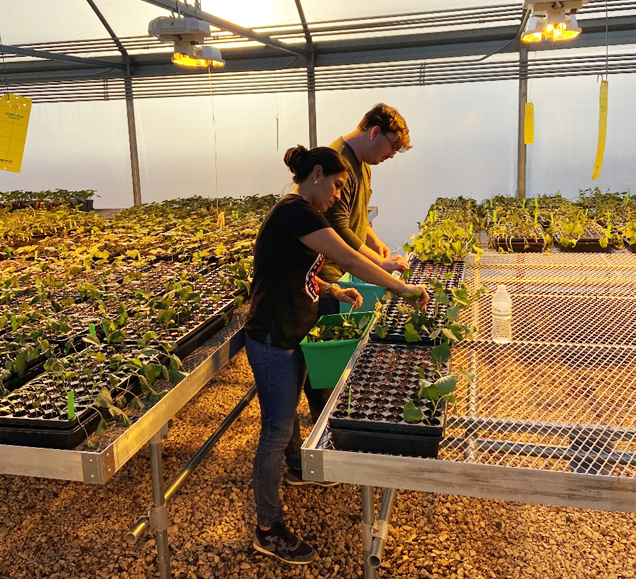
Sweet potatoes are the number one vegetable crop grown in North Carolina with annual cash receipts of more than $300 million. North Carolina is the number one producer of sweet potatoes in the United States. Golden LEAF has helped support this important crop through funding programs to enhance sweet potato disease control and plant production.
In April 2014, Golden LEAF awarded $125,068 to N.C. State University for various research efforts targeting internal necrosis in Covington sweet potatoes. Internal necrosis is a disease where the sweet potatoes develop black spots and patches on the inside of the root. Producers cannot tell if a root has internal necrosis without cutting into it. Sweet potatoes that have internal necrosis are not marketable.
Jonathan Schultheis, N.C. State Extension specialist and professor in the Department of Horticultural Science at N.C. State University, led the task force to study the disease. His team discovered that by changing the curing process — a heat treatment that encourages the roots to heal cuts and abrasions and converts starch into sugar after harvesting and before storing in a cool storage room — greatly reduces the incidence and severity of internal necrosis in Covington sweet potatoes.
“Sweet potatoes cannot be preconditioned in storage with lower temperatures as is done white potatoes,” said Schultheis. “Unlike the potato, the sweet potato is a tropical plant species and needs warmer storage temperatures. A sure way to rot the roots is to expose them to temperature below 55 degrees Fahrenheit.”
Schultheis also said, the sweet potato must be handled differently than white potatoes.
“Prior to this research, the processing industry was unfamiliar with the storage requirements of sweet potatoes,” he said. “This research helped them gain a better understanding. Storage over time can be optimized by holding roots in rooms maintained at 60 degrees Fahrenheit.”
Schultheis said Golden LEAF funds also enabled N.C. State to the build separate rooms in which larger scale work could be conducted to understand how storage conditions affect sweet potato root quality.
“These rooms were instrumental in being able to discover that the most widely grown sweet potato variety, Covington sweet potatoes, required more specific curing conditions than other sweet potato varieties to minimize the occurrence of internal necrosis,” said Schultheis.
“The investment by Golden LEAF leveraged funds from industry and the overall work conducted by research and extension faculty. The results from many diversified studies have propelled N.C. into the lead U.S. state with regards to production and sales of the sweet potato both nationally and internationally.”
Golden LEAF funds leveraged other resources for the internal necrosis task force including the North Carolina Agricultural Research Service, North Carolina Cooperative Extension, North Carolina Sweet Potato Commission, and the Covington Endowment.
Golden LEAF has supported the expansion of the state’s sweet potato industry by providing funding to N.C. State University to increase its capacity to grow certified disease-free sweet potato plants.
Approximately 90% of all sweet potato plants grown in North Carolina originate in N.C. State University greenhouses. Golden LEAF provided $200,000 in June 2016 to construct and operate new greenhouse facilities dedicated to certified sweet potato plant production in N.C., doubling its capacity.
Dr. Eric Davis, Department Head of Entomology and Plant Pathology at N.C. State University said four greenhouses were built on one site in the Horticulture Field Lab at N.C. State University for the exclusive use of the Micropropagation and Repository Unit (MPRU) to produce certified nuclear sweet potato plants.
“The nuclear plants are produced annually in the MPRU from tissue culture, which is certified to be disease-free and true-to-type by the N.C. Crop Improvement Association,” said Davis. “Between 10-12 individual N.C. certified sweet potato seed growers purchase the nuclear plants each year and mass propagate the certified elite plants to be sold and grown by N.C. sweet potato growers.”
Davis said the additional greenhouses have been instrumental in growing the amount of sweet potato plants available to growers.
“In the two years that the new greenhouses have been operational, the number of nuclear plants produced has increased to the equivalent of over 13,000 potted plants per year,” said Davis. “The funding for this greenhouse project from Golden LEAF was instrumental to project success. Greenhouse construction would have never gotten off the ground without Golden LEAF support.”
Support from the NC Certified Sweetpotato Growers Association, National Clean Plant Network, the NC State College of Agriculture and Life Sciences and Department of Entomology and Plant Pathology, and the MPRU combined with the initial support from Golden LEAF led to greenhouse construction completion.
“The development of high-quality sweet potato varieties by the breeding program at N.C. State University in combination with the production of certified sweet potato plants by the MPRU has helped to make North Carolina the number one in the nation in sweet potato production,” said Davis. “The use of certified sweet potato plants greatly reduces sweet potato crop losses to diseases and increases the export value of the crop.”